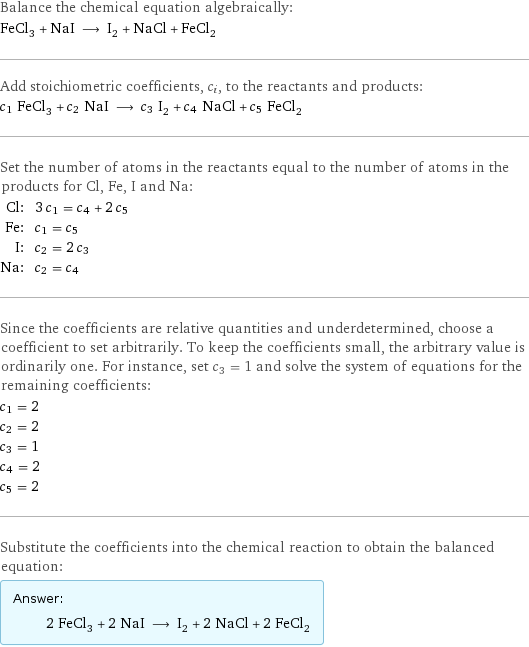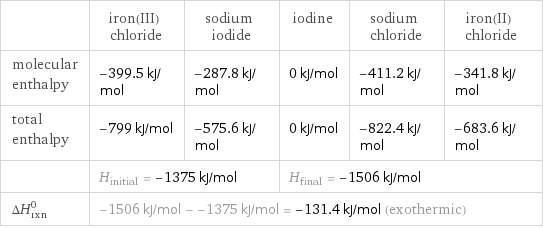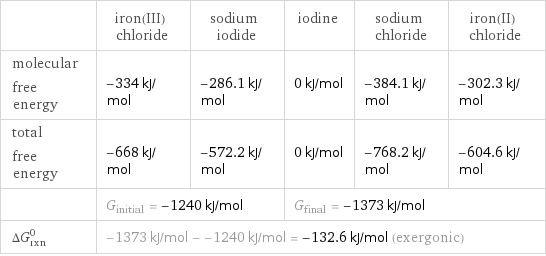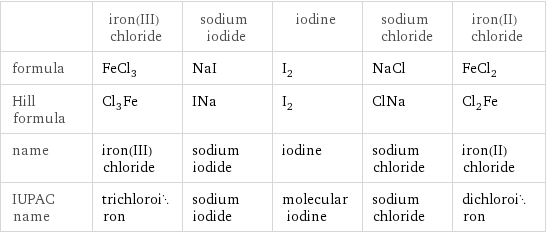Input interpretation

FeCl_3 iron(III) chloride + NaI sodium iodide ⟶ I_2 iodine + NaCl sodium chloride + FeCl_2 iron(II) chloride
Balanced equation

Balance the chemical equation algebraically: FeCl_3 + NaI ⟶ I_2 + NaCl + FeCl_2 Add stoichiometric coefficients, c_i, to the reactants and products: c_1 FeCl_3 + c_2 NaI ⟶ c_3 I_2 + c_4 NaCl + c_5 FeCl_2 Set the number of atoms in the reactants equal to the number of atoms in the products for Cl, Fe, I and Na: Cl: | 3 c_1 = c_4 + 2 c_5 Fe: | c_1 = c_5 I: | c_2 = 2 c_3 Na: | c_2 = c_4 Since the coefficients are relative quantities and underdetermined, choose a coefficient to set arbitrarily. To keep the coefficients small, the arbitrary value is ordinarily one. For instance, set c_3 = 1 and solve the system of equations for the remaining coefficients: c_1 = 2 c_2 = 2 c_3 = 1 c_4 = 2 c_5 = 2 Substitute the coefficients into the chemical reaction to obtain the balanced equation: Answer: | | 2 FeCl_3 + 2 NaI ⟶ I_2 + 2 NaCl + 2 FeCl_2
Structures

+ ⟶ + +
Names

iron(III) chloride + sodium iodide ⟶ iodine + sodium chloride + iron(II) chloride
Reaction thermodynamics
Enthalpy

| iron(III) chloride | sodium iodide | iodine | sodium chloride | iron(II) chloride molecular enthalpy | -399.5 kJ/mol | -287.8 kJ/mol | 0 kJ/mol | -411.2 kJ/mol | -341.8 kJ/mol total enthalpy | -799 kJ/mol | -575.6 kJ/mol | 0 kJ/mol | -822.4 kJ/mol | -683.6 kJ/mol | H_initial = -1375 kJ/mol | | H_final = -1506 kJ/mol | | ΔH_rxn^0 | -1506 kJ/mol - -1375 kJ/mol = -131.4 kJ/mol (exothermic) | | | |
Gibbs free energy

| iron(III) chloride | sodium iodide | iodine | sodium chloride | iron(II) chloride molecular free energy | -334 kJ/mol | -286.1 kJ/mol | 0 kJ/mol | -384.1 kJ/mol | -302.3 kJ/mol total free energy | -668 kJ/mol | -572.2 kJ/mol | 0 kJ/mol | -768.2 kJ/mol | -604.6 kJ/mol | G_initial = -1240 kJ/mol | | G_final = -1373 kJ/mol | | ΔG_rxn^0 | -1373 kJ/mol - -1240 kJ/mol = -132.6 kJ/mol (exergonic) | | | |
Equilibrium constant
![Construct the equilibrium constant, K, expression for: FeCl_3 + NaI ⟶ I_2 + NaCl + FeCl_2 Plan: • Balance the chemical equation. • Determine the stoichiometric numbers. • Assemble the activity expression for each chemical species. • Use the activity expressions to build the equilibrium constant expression. Write the balanced chemical equation: 2 FeCl_3 + 2 NaI ⟶ I_2 + 2 NaCl + 2 FeCl_2 Assign stoichiometric numbers, ν_i, using the stoichiometric coefficients, c_i, from the balanced chemical equation in the following manner: ν_i = -c_i for reactants and ν_i = c_i for products: chemical species | c_i | ν_i FeCl_3 | 2 | -2 NaI | 2 | -2 I_2 | 1 | 1 NaCl | 2 | 2 FeCl_2 | 2 | 2 Assemble the activity expressions accounting for the state of matter and ν_i: chemical species | c_i | ν_i | activity expression FeCl_3 | 2 | -2 | ([FeCl3])^(-2) NaI | 2 | -2 | ([NaI])^(-2) I_2 | 1 | 1 | [I2] NaCl | 2 | 2 | ([NaCl])^2 FeCl_2 | 2 | 2 | ([FeCl2])^2 The equilibrium constant symbol in the concentration basis is: K_c Mulitply the activity expressions to arrive at the K_c expression: Answer: | | K_c = ([FeCl3])^(-2) ([NaI])^(-2) [I2] ([NaCl])^2 ([FeCl2])^2 = ([I2] ([NaCl])^2 ([FeCl2])^2)/(([FeCl3])^2 ([NaI])^2)](../image_source/916dc204dd3f6c94a521e0359d4c124f.png)
Construct the equilibrium constant, K, expression for: FeCl_3 + NaI ⟶ I_2 + NaCl + FeCl_2 Plan: • Balance the chemical equation. • Determine the stoichiometric numbers. • Assemble the activity expression for each chemical species. • Use the activity expressions to build the equilibrium constant expression. Write the balanced chemical equation: 2 FeCl_3 + 2 NaI ⟶ I_2 + 2 NaCl + 2 FeCl_2 Assign stoichiometric numbers, ν_i, using the stoichiometric coefficients, c_i, from the balanced chemical equation in the following manner: ν_i = -c_i for reactants and ν_i = c_i for products: chemical species | c_i | ν_i FeCl_3 | 2 | -2 NaI | 2 | -2 I_2 | 1 | 1 NaCl | 2 | 2 FeCl_2 | 2 | 2 Assemble the activity expressions accounting for the state of matter and ν_i: chemical species | c_i | ν_i | activity expression FeCl_3 | 2 | -2 | ([FeCl3])^(-2) NaI | 2 | -2 | ([NaI])^(-2) I_2 | 1 | 1 | [I2] NaCl | 2 | 2 | ([NaCl])^2 FeCl_2 | 2 | 2 | ([FeCl2])^2 The equilibrium constant symbol in the concentration basis is: K_c Mulitply the activity expressions to arrive at the K_c expression: Answer: | | K_c = ([FeCl3])^(-2) ([NaI])^(-2) [I2] ([NaCl])^2 ([FeCl2])^2 = ([I2] ([NaCl])^2 ([FeCl2])^2)/(([FeCl3])^2 ([NaI])^2)
Rate of reaction
![Construct the rate of reaction expression for: FeCl_3 + NaI ⟶ I_2 + NaCl + FeCl_2 Plan: • Balance the chemical equation. • Determine the stoichiometric numbers. • Assemble the rate term for each chemical species. • Write the rate of reaction expression. Write the balanced chemical equation: 2 FeCl_3 + 2 NaI ⟶ I_2 + 2 NaCl + 2 FeCl_2 Assign stoichiometric numbers, ν_i, using the stoichiometric coefficients, c_i, from the balanced chemical equation in the following manner: ν_i = -c_i for reactants and ν_i = c_i for products: chemical species | c_i | ν_i FeCl_3 | 2 | -2 NaI | 2 | -2 I_2 | 1 | 1 NaCl | 2 | 2 FeCl_2 | 2 | 2 The rate term for each chemical species, B_i, is 1/ν_i(Δ[B_i])/(Δt) where [B_i] is the amount concentration and t is time: chemical species | c_i | ν_i | rate term FeCl_3 | 2 | -2 | -1/2 (Δ[FeCl3])/(Δt) NaI | 2 | -2 | -1/2 (Δ[NaI])/(Δt) I_2 | 1 | 1 | (Δ[I2])/(Δt) NaCl | 2 | 2 | 1/2 (Δ[NaCl])/(Δt) FeCl_2 | 2 | 2 | 1/2 (Δ[FeCl2])/(Δt) (for infinitesimal rate of change, replace Δ with d) Set the rate terms equal to each other to arrive at the rate expression: Answer: | | rate = -1/2 (Δ[FeCl3])/(Δt) = -1/2 (Δ[NaI])/(Δt) = (Δ[I2])/(Δt) = 1/2 (Δ[NaCl])/(Δt) = 1/2 (Δ[FeCl2])/(Δt) (assuming constant volume and no accumulation of intermediates or side products)](../image_source/84d093e79bb18caf0945b062a26d93fd.png)
Construct the rate of reaction expression for: FeCl_3 + NaI ⟶ I_2 + NaCl + FeCl_2 Plan: • Balance the chemical equation. • Determine the stoichiometric numbers. • Assemble the rate term for each chemical species. • Write the rate of reaction expression. Write the balanced chemical equation: 2 FeCl_3 + 2 NaI ⟶ I_2 + 2 NaCl + 2 FeCl_2 Assign stoichiometric numbers, ν_i, using the stoichiometric coefficients, c_i, from the balanced chemical equation in the following manner: ν_i = -c_i for reactants and ν_i = c_i for products: chemical species | c_i | ν_i FeCl_3 | 2 | -2 NaI | 2 | -2 I_2 | 1 | 1 NaCl | 2 | 2 FeCl_2 | 2 | 2 The rate term for each chemical species, B_i, is 1/ν_i(Δ[B_i])/(Δt) where [B_i] is the amount concentration and t is time: chemical species | c_i | ν_i | rate term FeCl_3 | 2 | -2 | -1/2 (Δ[FeCl3])/(Δt) NaI | 2 | -2 | -1/2 (Δ[NaI])/(Δt) I_2 | 1 | 1 | (Δ[I2])/(Δt) NaCl | 2 | 2 | 1/2 (Δ[NaCl])/(Δt) FeCl_2 | 2 | 2 | 1/2 (Δ[FeCl2])/(Δt) (for infinitesimal rate of change, replace Δ with d) Set the rate terms equal to each other to arrive at the rate expression: Answer: | | rate = -1/2 (Δ[FeCl3])/(Δt) = -1/2 (Δ[NaI])/(Δt) = (Δ[I2])/(Δt) = 1/2 (Δ[NaCl])/(Δt) = 1/2 (Δ[FeCl2])/(Δt) (assuming constant volume and no accumulation of intermediates or side products)
Chemical names and formulas

| iron(III) chloride | sodium iodide | iodine | sodium chloride | iron(II) chloride formula | FeCl_3 | NaI | I_2 | NaCl | FeCl_2 Hill formula | Cl_3Fe | INa | I_2 | ClNa | Cl_2Fe name | iron(III) chloride | sodium iodide | iodine | sodium chloride | iron(II) chloride IUPAC name | trichloroiron | sodium iodide | molecular iodine | sodium chloride | dichloroiron
Substance properties

| iron(III) chloride | sodium iodide | iodine | sodium chloride | iron(II) chloride molar mass | 162.2 g/mol | 149.89424 g/mol | 253.80894 g/mol | 58.44 g/mol | 126.7 g/mol phase | solid (at STP) | solid (at STP) | solid (at STP) | solid (at STP) | solid (at STP) melting point | 304 °C | 661 °C | 113 °C | 801 °C | 677 °C boiling point | | 1300 °C | 184 °C | 1413 °C | density | | 3.67 g/cm^3 | 4.94 g/cm^3 | 2.16 g/cm^3 | 3.16 g/cm^3 solubility in water | | | | soluble | dynamic viscosity | | 0.0010446 Pa s (at 691 °C) | 0.00227 Pa s (at 116 °C) | | odor | | | | odorless |
Units
